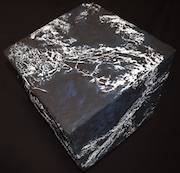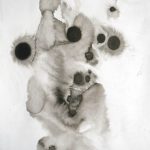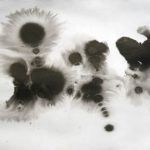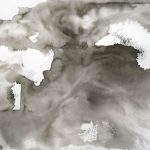ROBERT RICH Interview for Greek “High Fidelity” Magazine
July 10, 2009
with Fanis Kostouros
FK) Tell us please, when and how did your involvement with music start?
RR) I grew up in a family of music lovers. One of my grandfathers was an early audiophile in the 1960’s, with home-built speakers and Dynakit amplifiers with reel-to-reel copies of his collection of 78 RPM big band jazz records. I remember hearing Django Reinhart and Louis Armstrong before I was 5 years old. My father has played jazz guitar since 1955, and still plays weekly in a restaurant near his home.
When I was very young, I wasn’t sure I liked “music” because I didn’t know what I liked. Later, around age 10 (early 70’s) I discovered psychedelic and progressive rock with little understanding of its background, and then quickly expanded my interest into the sounds of nature, minimalism, German space-music, early “industrial” bands, Indonesian gamelan and classical Indian music. I became a musical omnivore, most interested in the fringe. I especially liked music with a mysterious edge, something unknown and surprising.
I first played an instrument around age 11, learning viola for a few months until I got shy about my inability to read music. I memorized the notes by ear because the dots on paper didn’t make sense to me. I also sang in choir for a few years, but that ended when I stopped going to church. I began improvising on piano around age 12, then started building synthesizer kits a year later, around 1977 I think. I slowly built a cheap modular synthesizer that I could almost perform with. I wanted to sound like Klaus Schultz or Popol Vuh, but I was young, inexperienced, and my equipment was very primitive; so I could only make strange noises with my homemade gear. In late 1979 I started an improvising group with two new friends (Jon Spencer and Rick Davies) who shared my fringe musical tastes. We only played one show. We remain close friends still, but I realized that I needed to follow my own private muse, so I worked on solo music mostly after that.
FK) You are actually a multi keyboard player. How did electronica become your main musical interest?
RR) I don’t think in terms of specific instruments, or styles, but in terms of the sound texture itself. I like the surreal character of electronics, and the expressive character of acoustic instruments. My preference lies in the middle. I sense the merging of sounds in terms of texture, more tactile than auditory. So I try to blend the synthetic with the organic, in a way that feels natural to me. I don’t think that I play any one instrument very well; and especially since I had a big hand injury a few years ago, I don’t play keyboards well anymore. I work primarily on the level of pure sound, and I try to make things fit in the best way I know how. I consider my first instrument to be piano or analog modular synthesizer. Maybe modular synth is my most natural vocabulary.
FK) You released your first works in Europe before you returned to USA and started dealing with H.O.S. In Europe people used to believe that Americans are less open to any kind of experimental or progressive forms than Europeans. Do you share this option? If yes, how do you explain it?
RR) Maybe it’s easy to think, “The grass is always greener on the other side of the ocean.” I think that anyone who makes fringe music should feel happy when listeners become interested. I don’t have a strong opinion about where the best audience lives. It’s always a minority. Maybe some of my most intense fans are in Russia, but most music there is bootlegged, so I don’t hear from most of those listeners. I released my first few albums myself, in the early ‘80s, and I felt like I was alone in my interests. Then, some people in northern Europe discovered my music, and offered to release some albums (specifically Hans Fahlberg in Sweden and Serge LeRoy in France.) I was very young still (20-25 years old) and happy to have some listeners. Then, when I sent a more approachable album to Stephen Hill of Hearts of Space, he came up with a way to sell it to a mainstream audience. That increased sales from 1000 copies to 50,000. Most of those sales were in the USA, so I can’t generalize.
FK) Your period in H.O.S. was rather short but successful. Did it really help your career?
RR) It was a good ten years. HOS helped in a huge way. There was a window of time (late ‘80s to early ‘90s) when more “interesting” music could sell to a “new age” audience. After that, “interesting” music became harder to sell (unless people could dance to it), and “new age” solidified into insipid background music. Stephen Hill at HOS has always supported my efforts, ever since I sent him my first tape in 1980 for his radio show. He tried to find a way to sell my art-music to the general public. It worked for a few years. He still supports my efforts: even after he sold his label, he still plays my new music on his radio show. I was a stubborn artist, and I could only make the albums that came to me truthfully. It’s in my blood. I had to follow my own voice, and that voice became increasingly non-commercial again, as time went on. I think my last CD with HOS was one of my best – Seven Veils in 1998. I still play pieces from that album in concert. It amazes me that HOS supported my deep-listening albums like Stalker and Fissures – among my best collaborations. They were willing to take the risk.
FK) How did the famous Sleep Concerts come up, and what do you remember most about them?
RR) The idea of very long musical performance is ancient, and comes from many cultures. I think it’s a basic part of the way music can be used in ritual. Before I discovered those traditions, I taught myself how to listen to the world around me as music. As a child I would stay awake on rainy winter nights, listening to water in the distance, and it became music to me, with infinite fractal melodies. The sounds of frogs in the springtime taught me polyrhythm. The sounds of birds echoing through the trees taught me an ideal reverb. So later, when I first heard Indonesian gamelan, it sounded like nature. I learned that Wayang puppet plays would sometimes last for days, with the whole village staying out to participate. This seemed perfect. Performances of North Indian classical music can also last for 6-8 hours. Navaho healing chants could last for 3 days without pause. It occurred to me that something must be happening, late at night, when the mind is skimming across the shallow waters between sleep and consciousness. I wanted to try to make sound that would act like the thread that cave explorers might let out behind themselves as they climb deeper into the darkness, to help them find their way back — a thread of continuity between two states of consciousness.
I also wanted the sleep concerts to act as a community ritual, something that would bring people together in a distinctive way, an action that would discern itself from the mundane. For ritual to function, it needs to be separate from everyday behavior, a shift of expectation. I felt that individuals in our culture have become so isolated from each other, that a ritual could attempt to pop the bubbles of distance we hold between us. What could be more intimate than sleep, what more private? Would there be a way to allow people to share this private space without threatening its sanctity? Perhaps a dual function could occur with these performances, that the expectation of “sleep music” would encourage people to listen to sound more deeply, for a longer duration, and it would also bring people together in a community ritual. I doubt that it ever succeeded in such a grandiose way, but it seemed worth trying.
Many of my memories of performing the sleep concerts are blurred by the exhaustion that would always follow; but I do have some snapshots in my mind, frozen in time, sense-memories of thick atmospheres. My favorite memory comes from an early sleep concert in Berkeley, California. In the morning, some people started to head home, while some stayed quietly in the room as I packed my equipment. A woman returned to the room after trying to leave. She said, “I went outside to go to my car, but everything felt so loud I had to come back in.” The music made her too sensitive to the outside noise. I considered this a success, to sensitize a listener to the world around her.
FK) From Sunyata of 1982, technology had enormous progress. I guess your own studio is a top quality one by now. Do you still enjoy using your old equipment in your recent works?
RR) Well, first of all, my studio is usually a few years behind modern. But I try to find the gear that will last beyond fads. I have a picky ear, and I want to buy only a few pieces of gear that will last a long time. I don’t cycle through a lot of equipment. I keep some old things that still sound good. I wait to replace things until they don’t work any longer. Some of my old equipment still lives with me in the studio: I still have a DX7II from 1988, Eventide H3000 from 1989, Korg Wavestation from 1991. I waited to sell my 1983 Sequential Prophet 5 until 2005. My big MOTM analog modular synthesizer could have been modern in 1970, but it’s new and always growing, since 1999. People spend too much time thinking about equipment. Equipment is important, but secondary to intention. Probably the best tools in my studio are the Duntech Sovereign speakers, which were built in 1987, and I bought used in 1999. Those speakers have been essential for my success as a mastering engineer. I love to work with speakers that I can trust.
FK) You are supposed to be a great ambient-electronica artist. You use acoustic instruments quite often though. Is it still a priority for you to mix these two “worlds” ?
RR) It comes naturally. I love the boundary between surreal and expressive. Furthermore, my live shows can be a bit more interesting because I play flute and lap steel guitar along with the electronics. These days, performers just sit behind a laptop computer on stage – they might as well be doing their email.
The acoustic instruments retain a complexity that tickles my ears, and they convey emotion from the human unconscious that evades analysis. The electronic instruments form a more compositional framework, a bed of sound-design and abstraction that puts the experience into a new context. The merger between acoustic and electronic, when orchestrated with sensitivity, can build a very evocative experience that blends the best of emotion with intention, improvisation with composition. It suits my ear.
FK) Your last CD named Zerkalo is a collaboration with Russian drone artist Andrey Sadovnikov. As far as I know, you’ve never met each other. How interesting was this experience for you?
RR) To be honest, I prefer to work with collaborators in person. Otherwise, it’s not as much fun. For Andrey, this was not possible, and I did not expect it. I was willing to try something different. Zerkalo felt a bit like a solo album where I didn’t have to record every sound. When I received Andrey’s drones, I assembled them on a time line and carved a continuum from them. I recorded my additions alone, then mixed and mastered the album alone. I regret we couldn’t make it together, but I do like the results nevertheless. I still want to meet Andrey. The best part of collaboration is the friendship. After all, we collaborators become parents of this child together (the music.) Without the friendship and interpersonal connection, the best pleasure is missing from the act of creation.
FK) A lot of ambient giants like Eno or Schulze, had perfect personal albums and successful collaborations as well. What do you prefer for yourself?
RR) I like both the solo recordings and the collaborations for different reasons. Collaborations usually go faster, so I don’t get so familiar with the music. That allows me to listen to the music with fresh ears later on. I also love the exchange of ideas and techniques. We help each other. However, since collaborations go more quickly, I tend to fall back on things that feel familiar, relying upon older skills that I know will work. When I make a solo album, I can spend more time concentrating on new ideas, new approaches. I can find a new voice sometimes, new vocabularies. This helps me more in the future, to develop my art. This is when I can take time to ponder my direction, and follow without compromise. Both are good.
FK) You are also a perfect sound engineer. Tell us about the importance of high quality sound in music, when at the same time illegal downloading is killing music…
RR) Thank you for the compliment, but I think “perfect” sound is a fiction, and certainly I am not a perfect sound engineer. Nothing from a speaker sounds like the real world, and nothing from an electronic production environment can replace our experience in nature. Personally, I just try to make recorded sound into a sensual experience, more like making perfume or weaving a fabric. I feel sound on my skin. I want it to be delicious, beautiful, seductive.
I am trying my best to help correct the direction of current mainstream recording. I’m a mastering engineer when I am not working on my own music. I have been teaching a college class on audio mastering, and lecture occasionally on the subject. I am trying to teach people to hear the artifacts of over-loud limited music, trying to preach the gospel of dynamics and subtlety in recorded music. But it’s a tough battle because loudness is seductive. Sadly, the data-compressed delivery systems (MP3 etc.) that people have become accustomed to, sound even worse when conveying dynamically compressed music. So, the standards seem to keep dropping at the same time as our technology allows better and better recording.
Are downloads killing music? Maybe, or maybe they offer new possibilities. My hope is that music lovers will realize that the Internet provides a means to hear even better audio recordings, at full resolution directly from a download, from the artist’s computer, uncompressed. We can avoid all these battling formats (DVD-A, SACD, etc.) and just download full resolution directly. The problem is, that nobody will offer this service if it just means giving away the masters to a bootleg website.
If I spend a year recording an album, then everyone gets the music free from a bootleg site, I feel like nobody cares and I probably won’t work so hard on the next release. It’s a negative feedback loop, a downer. I’m saying this as a small independent artist, not a big record label. I simply don’t know what to do about it. It makes me feel like Sysyphus, pushing the boulder up the mountain each time only to see it roll back down. I can’t blame people for the attraction of free music, so I try the best I can to remain an artist who earns the loyalty of a few listeners, who might actually want to pay for a few CDs or maybe come to a concert. Otherwise, yes, I’ll probably stop releasing music on CD if it feels like a waste of effort.
FK) What mainly inspires you in composing music, and how do you enjoy spending your time apart from music?
RR) I never really know where my music comes from. It seems to percolate up from some subterranean well, a sort of life-spring that also drives me in other ways. If I didn’t make music I’m sure I would still be trying to express this mystery somehow, hoping that someday I will understand it. What really gives me pleasure is making things, growing things, creating a result I can hold in my hands. When I am not in the studio working on my own music, or other peoples’ music, I go for long walks down the creek trail near our house. In the winter I collect mushrooms in the mountains nearby. I make wine every year from Cabernet and Syrah grapes that I pick from local vineyards. We grow vegetables in our garden. We cook for our friends. I write about food and wine, and I enjoy more creative writing when I feel inspired. I play around with electronics, with lasers, ceramics, painting, everything that inspires me.
FK) How do you feel ambient music can work or even help people in times like this which are full of anger and stress?
RR) Well, your question answers itself, doesn’t it? At least for me, it’s a natural response to become more introspective in darker times. Perhaps other people tend to react with anger or righteousness. I fear there is already a strong feedback loop between the violence in the world and violence in media and art. Rather than echo the external world and its fears, I prefer to offer a more hopeful alternative. Some people might criticize the artists who try to create beauty, as Utopian, or shirking their responsibility to solve injustice in the world. Yet I feel that the level of noise (psychic noise, I mean) in our world has gotten so bad that echoing the dark energies serves to amplify that noise. Instead I want to improve the signal to noise ratio of our environment; and to accomplish that, I think it’s important to become more quiet, kinder, more introspective, more tolerant.
FK) What do you expect from your audience during a live performance? And what is this that they have to expect from you?
RR) My favorite live concerts occur when I feel free to improvise, where neither the audience nor I know what to expect. Sometimes these concerts are slower and require a bit more patience from the listener, but I think they can become magical. I love those moments when the atmosphere gets energized, and time becomes elastic. In less intimate environments, when the audience expects more traditional “entertainment” I feel a bit constrained to playing my more active melodic music. This is also OK but I think the results are less likely to find magic.
FK) Any plans for near future?
RR) I am working on a new album right now, which is definitely more rhythmic and melodic than some of my recent releases. Working title is “Ylang” (from the essential oil ylang ylang.) It has drums and bass lines, a sort mutant trance-jazz with slow tempos, odd time signatures, sometimes a feel of dub or Indian raga. I think it might surprise a few of my fans, but they are accustomed to surprises from me by now. After I finish the new album, I hope to do some more concerts, probably in 2010, perhaps even in Europe.
FK) I guess these are more than enough!






You must be logged in to post a comment.